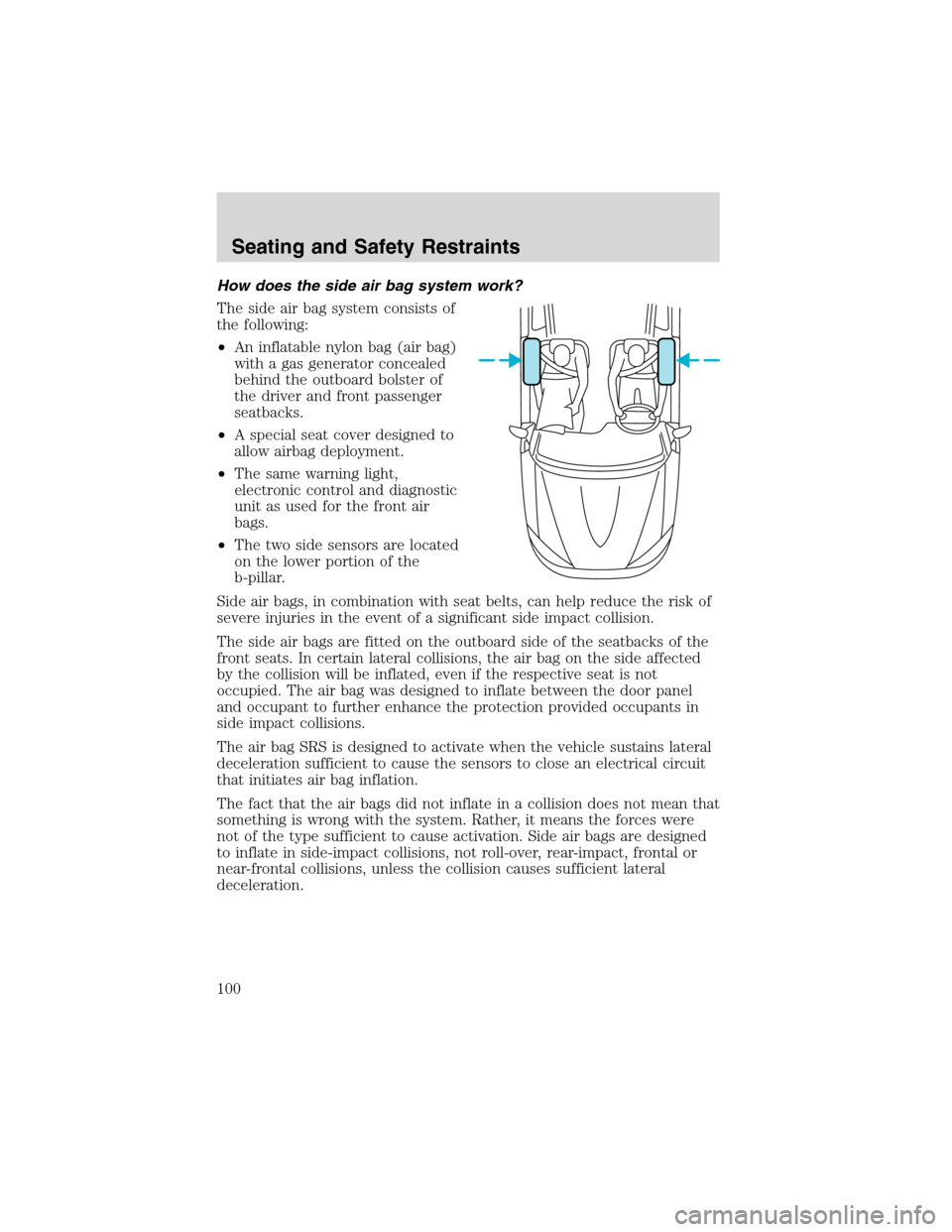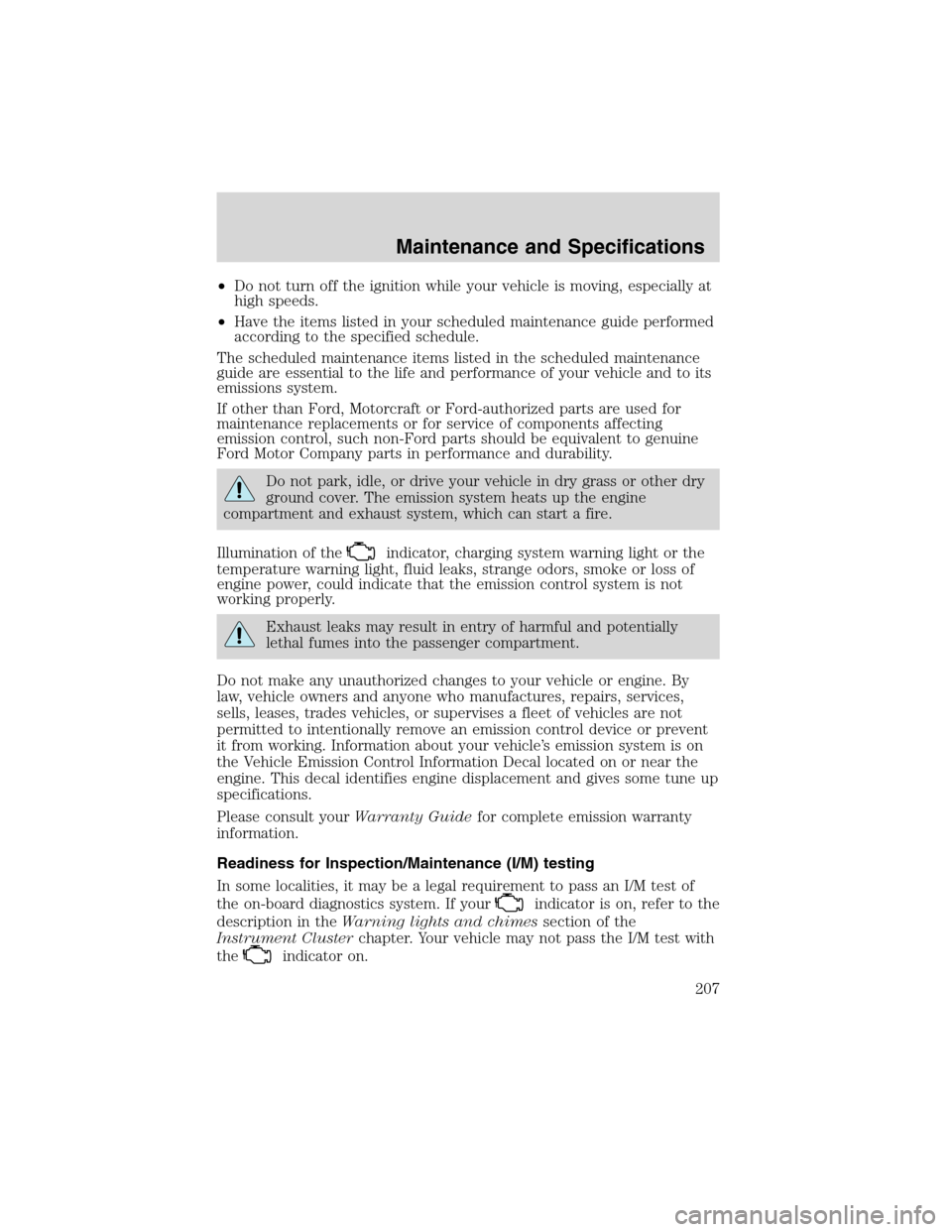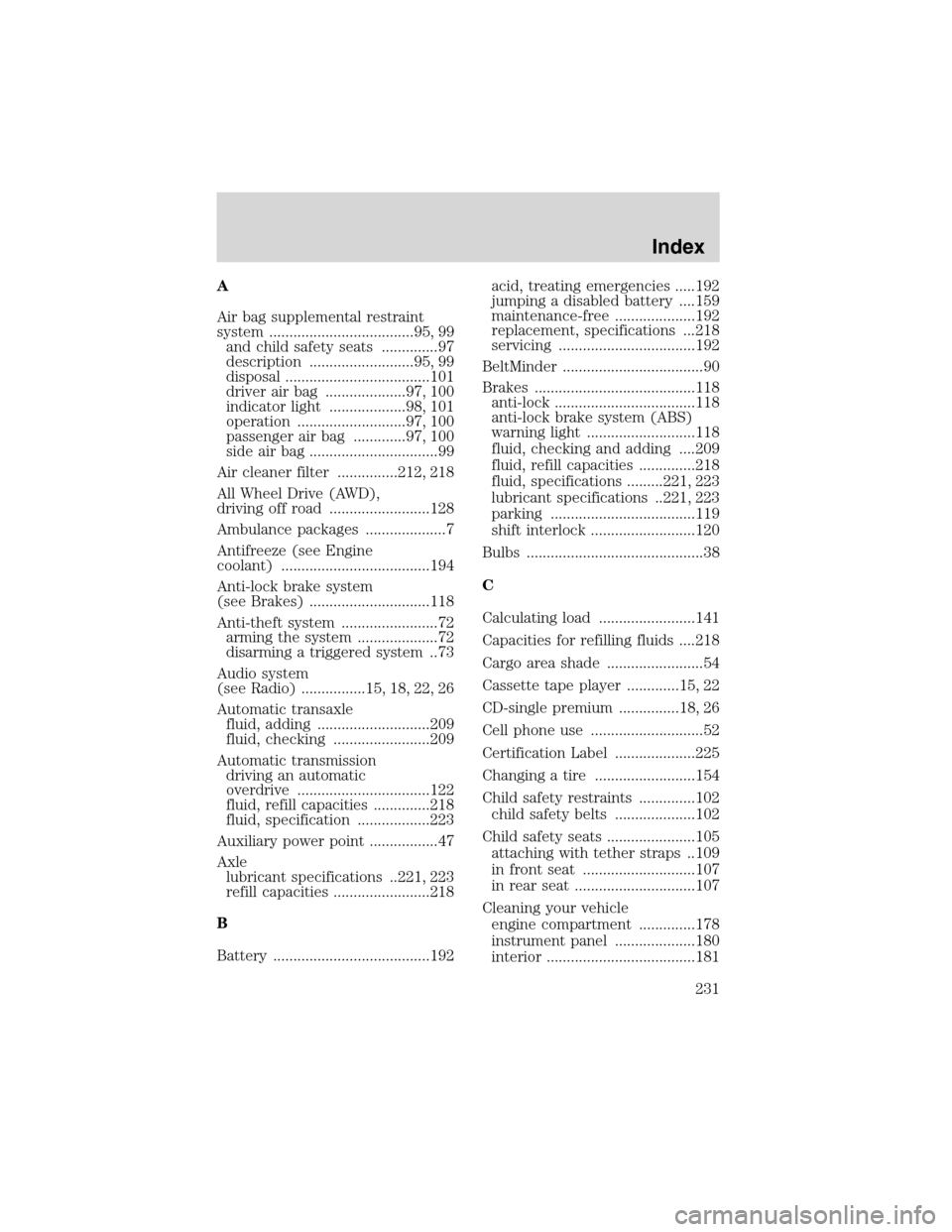warning light FORD ESCAPE 2003 1.G User Guide
[x] Cancel search | Manufacturer: FORD, Model Year: 2003, Model line: ESCAPE, Model: FORD ESCAPE 2003 1.GPages: 240, PDF Size: 2.6 MB
Page 100 of 240

How does the side air bag system work?
The side air bag system consists of
the following:
•An inflatable nylon bag (air bag)
with a gas generator concealed
behind the outboard bolster of
the driver and front passenger
seatbacks.
•A special seat cover designed to
allow airbag deployment.
•The same warning light,
electronic control and diagnostic
unit as used for the front air
bags.
•The two side sensors are located
on the lower portion of the
b-pillar.
Side air bags, in combination with seat belts, can help reduce the risk of
severe injuries in the event of a significant side impact collision.
The side air bags are fitted on the outboard side of the seatbacks of the
front seats. In certain lateral collisions, the air bag on the side affected
by the collision will be inflated, even if the respective seat is not
occupied. The air bag was designed to inflate between the door panel
and occupant to further enhance the protection provided occupants in
side impact collisions.
The air bag SRS is designed to activate when the vehicle sustains lateral
deceleration sufficient to cause the sensors to close an electrical circuit
that initiates air bag inflation.
The fact that the air bags did not inflate in a collision does not mean that
something is wrong with the system. Rather, it means the forces were
not of the type sufficient to cause activation. Side air bags are designed
to inflate in side-impact collisions, not roll-over, rear-impact, frontal or
near-frontal collisions, unless the collision causes sufficient lateral
deceleration.
Seating and Safety Restraints
100
Page 114 of 240

STARTING
Positions of the ignition
1. LOCK, locks the gearshift lever
and allows key removal.
2. ACCESSORY, allows the electrical
accessories such as the radio to
operate while the engine is not
running.
3. RUN, all electrical circuits
operational and warning lights will
illuminate. This is the position the
key is in when you’re driving.
4. START, cranks the engine. Release the key as soon as the engine
starts.
Preparing to start your vehicle
Engine starting is controlled by the powertrain control system. This
system meets all Canadian Interference-Causing Equipment standard
requirements regulating the impulse electrical field strength of radio
noise.
When starting a fuel-injected engine, don’t press the accelerator before
or during starting. Only use the accelerator when you have difficulty
starting the engine. For more information on starting the vehicle, refer to
Starting the enginein this chapter.
Extended idling at high engine speeds can produce very high
temperatures in the engine and exhaust system, creating the risk
of fire or other damage.
Do not park, idle, or drive your vehicle in dry grass or other dry
ground cover. The emission system heats up the engine
compartment and exhaust system, which can start a fire.
Do not start your vehicle in a closed garage or in other enclosed
areas. Exhaust fumes can be toxic. Always open the garage door
before you start the engine. SeeGuarding against exhaust fumesin
this chapter for more instructions.
Driving
114
Page 118 of 240

BRAKES
Occasional brake noise is normal. If a metal-to-metal, continuous grinding
or continuous squeal sound is present, the brake linings may be worn-out
and should be inspected by a qualified service technician. If the vehicle
has continuous vibration or shudder in the steering wheel while braking,
the vehicle should be inspected by a qualified service technician.
Brakes
Under normal operating conditions, brake dust may accumulate on the
wheels. Some brake dust is inevitable as brakes wear and does not
contribute to brake noise. The use of modern friction materials with
emphasis on improved performance and environmental considerations
can lead to more dust than in the past. Brake dust can be cleaned by
weekly washing with soapy water and a soft sponge. Heavier deposits can
be removed with Motorcraft Wheel and Tire Cleaner (ZC-37–A).
Four-wheel anti-lock brake system (ABS) (if equipped)
Your vehicle may be equipped with an Anti-lock Braking System (ABS).
This system helps you maintain steering control during emergency stops
by keeping the brakes from locking. Noise from the ABS pump motor
and brake pedal pulsation may be observed during ABS braking; any
pulsation or mechanical noise you may feel or hear is normal.
Using ABS
When hard braking is required, apply continuous force on the brake
pedal; do not pump the brake pedal since this will reduce the
effectiveness of the ABS and will increase your vehicle’s stopping
distance. The ABS will be activated immediately, allowing you to retain
full steering control during hard braking and on slippery surfaces.
However, the ABS does not decrease stopping distance.
ABS warning lamp
ABS
TheABSlamp in the instrument cluster momentarily illuminates when
the ignition is turned to ON. If the light does not illuminate during start
up, remains on or flashes, the ABS may be disabled and the ABS may
need to be serviced
Even when the ABS is disabled,
normal braking is still effective. (If
your BRAKE warning lamp
illuminates with the parking brake
released, have your brake system
serviced immediately.)
!
BRAKE
Driving
118
Page 119 of 240

Parking brake
To set the parking brake (1), pull
the parking brake handle up as far
as possible. The BRAKE warning
lamp will illuminate and will remain
illuminated until the parking brake
is released.
To release, press and hold the button (2), pull the handle up slightly,
then push the handle down.
Always set the parking brake fully and make sure that the
gearshift is securely latched in P (Park) (automatic
transmission) or in 1 (First) (manual transmission).
STEERING
To prevent damage to the power steering system:
•Never hold the steering wheel at its furthest turning points (until it
stops) for more than a few seconds when the engine is running.
•Do not operate the vehicle with a low power steering pump fluid level
(below the MIN mark on the reservoir).
If the power steering system breaks down (or if the engine is turned
off), you can steer the vehicle manually, but it takes more effort.
If the steering wanders or pulls, check for:
•an underinflated tire
•uneven tire wear
•loose or worn suspension components
•loose or worn steering components
•improper steering alignment
PREPARING TO DRIVE YOUR VEHICLE
Utility vehicles have a significantly higher rollover rate than
other types of vehicles.
In a rollover crash, an unbelted person is significantly more likely
to die than a person wearing a safety belt.
!
BRAKE
Driving
119
Page 131 of 240

If your vehicle gets stuck
If your vehicle gets stuck in mud or snow it may be rocked out by
shifting between forward and reverse gears, stopping between shifts, in a
steady pattern. Press lightly on the accelerator in each gear.
Do not rock the vehicle if the engine is not at normal operating
temperature or damage to the transmission may occur.
Do not rock the vehicle for more than a few minutes or damage
to the transmission and tires may occur or the engine may
overheat.
Always set the parking brake fully and make sure the gearshift is
latched in P (Park). Turn the ignition to the LOCK position and
remove the key whenever you leave your vehicle.
If the parking brake is fully released, but the brake warning lamp
remains illuminated, the brakes may not be working properly.
See your dealer or a qualified service technician.
Do not spin the wheels at over 56 km/h (35 mph). The tires may
fail and injure a passenger or bystander.
Emergency maneuvers
•In an unavoidable emergency situation where a sudden sharp turn
must be made, remember to avoid“over-driving”your vehicle, i.e.,
turn the steering wheel only as rapidly and as far as required to avoid
the emergency. Excessive steering will result in less vehicle control,
not more. Additionally, smooth variations of the accelerator and/or
brake pedal pressure should be utilized if changes in vehicle speed are
called for. Avoid abrupt steering, acceleration or braking which could
result in an increased risk of loss of vehicle control, vehicle rollover
and/or personal injury. Use all available road surface to return the
vehicle to a safe direction of travel.
•In the event of an emergency stop, avoid skidding the tires and do not
attempt any sharp steering wheel movements.
Driving
131
Page 207 of 240

•Do not turn off the ignition while your vehicle is moving, especially at
high speeds.
•Have the items listed in your scheduled maintenance guide performed
according to the specified schedule.
The scheduled maintenance items listed in the scheduled maintenance
guide are essential to the life and performance of your vehicle and to its
emissions system.
If other than Ford, Motorcraft or Ford-authorized parts are used for
maintenance replacements or for service of components affecting
emission control, such non-Ford parts should be equivalent to genuine
Ford Motor Company parts in performance and durability.
Do not park, idle, or drive your vehicle in dry grass or other dry
ground cover. The emission system heats up the engine
compartment and exhaust system, which can start a fire.
Illumination of the
indicator, charging system warning light or the
temperature warning light, fluid leaks, strange odors, smoke or loss of
engine power, could indicate that the emission control system is not
working properly.
Exhaust leaks may result in entry of harmful and potentially
lethal fumes into the passenger compartment.
Do not make any unauthorized changes to your vehicle or engine. By
law, vehicle owners and anyone who manufactures, repairs, services,
sells, leases, trades vehicles, or supervises a fleet of vehicles are not
permitted to intentionally remove an emission control device or prevent
it from working. Information about your vehicle’s emission system is on
the Vehicle Emission Control Information Decal located on or near the
engine. This decal identifies engine displacement and gives some tune up
specifications.
Please consult yourWarranty Guidefor complete emission warranty
information.
Readiness for Inspection/Maintenance (I/M) testing
In some localities, it may be a legal requirement to pass an I/M test of
the on-board diagnostics system. If your
indicator is on, refer to the
description in theWarning lights and chimessection of the
Instrument Clusterchapter. Your vehicle may not pass the I/M test with
the
indicator on.
Maintenance and Specifications
207
Page 231 of 240

A
Air bag supplemental restraint
system ....................................95, 99
and child safety seats ..............97
description ..........................95, 99
disposal ....................................101
driver air bag ....................97, 100
indicator light ...................98, 101
operation ...........................97, 100
passenger air bag .............97, 100
side air bag ................................99
Air cleaner filter ...............212, 218
All Wheel Drive (AWD),
driving off road .........................128
Ambulance packages ....................7
Antifreeze (see Engine
coolant) .....................................194
Anti-lock brake system
(see Brakes) ..............................118
Anti-theft system ........................72
arming the system ....................72
disarming a triggered system ..73
Audio system
(see Radio) ................15, 18, 22, 26
Automatic transaxle
fluid, adding ............................209
fluid, checking ........................209
Automatic transmission
driving an automatic
overdrive .................................122
fluid, refill capacities ..............218
fluid, specification ..................223
Auxiliary power point .................47
Axle
lubricant specifications ..221, 223
refill capacities ........................218
B
Battery .......................................192acid, treating emergencies .....192
jumping a disabled battery ....159
maintenance-free ....................192
replacement, specifications ...218
servicing ..................................192
BeltMinder ...................................90
Brakes ........................................118
anti-lock ...................................118
anti-lock brake system (ABS)
warning light ...........................118
fluid, checking and adding ....209
fluid, refill capacities ..............218
fluid, specifications .........221, 223
lubricant specifications ..221, 223
parking ....................................119
shift interlock ..........................120
Bulbs ............................................38
C
Calculating load ........................141
Capacities for refilling fluids ....218
Cargo area shade ........................54
Cassette tape player .............15, 22
CD-single premium ...............18, 26
Cell phone use ............................52
Certification Label ....................225
Changing a tire .........................154
Child safety restraints ..............102
child safety belts ....................102
Child safety seats ......................105
attaching with tether straps ..109
in front seat ............................107
in rear seat ..............................107
Cleaning your vehicle
engine compartment ..............178
instrument panel ....................180
interior .....................................181
Index
231
Page 234 of 240

J
Jack ............................................154
positioning ...............................154
storage .....................................154
Jump-starting your vehicle ......159
K
Keys
positions of the ignition .........114
L
Lamps
autolamp system .......................33
bulb replacement
specifications chart ..................38
cargo lamps ...............................34
daytime running light ...............33
fog lamps ...................................33
headlamps .................................33
headlamps, flash to pass ..........34
instrument panel, dimming .....34
interior lamps .....................36–38
replacing bulbs ....... 38–39, 41–42
Lane change indicator
(see Turn signal) ........................36
Liftgate ........................................53
Lights, warning and indicator ....10
anti-lock brakes (ABS) ..........118
Load limits .................................139
GAWR ......................................139
GVWR ......................................139
trailer towing ..........................139
Loading instructions .................140
Locks
childproof ..................................65
Lubricant specifications ...221, 223
Lumbar support, seats .........76–77M
Manual transaxle .......................125
fluid, checking and adding ....211
reverse .....................................126
Manual transmission
fluid capacities ........................218
lubricant specifications ..........223
Mirrors .........................................46
automatic dimming rearview
mirror ........................................47
fold away ...................................49
heated ........................................49
side view mirrors (power) .......49
Moon roof ....................................53
Motorcraft parts ................203, 218
O
Octane rating ............................202
Oil (see Engine oil) ..................188
Overdrive ...................................122
P
Parking .......................................127
Parking brake ............................119
Parts (see Motorcraft parts) ....218
Power distribution box
(see Fuses) ...............................151
Power door locks ........................63
Power point .................................47
Power steering ..........................119
fluid, checking and adding ....208
fluid, refill capacity ................218
fluid, specifications .........221, 223
Power Windows ...........................48
Index
234
Page 235 of 240

Preparing to drive your
vehicle ........................................119
R
Radio ..........................15, 18, 22, 26
Rear window defroster ...............32
Relays ........................................147
Remote entry system
illuminated entry ......................69
locking/unlocking doors ...........63
Reverse sensing system ...........137
Roof rack .....................................55
S
Safety belts (see Safety
restraints) ..............................84–88
Safety defects, reporting ..........176
Safety restraints ....................84–88
belt minder ...............................90
cleaning the safety belts ..........94
extension assembly ..................89
for adults .............................85–87
for children .............................102
lap belt ......................................89
warning light and chime ..........90
Safety seats for children ..........105
Seat belts (see Safety
restraints) ....................................84
Seats ............................................74
child safety seats ....................105
heated ........................................76
Servicing your vehicle ..............183
Snowplowing .................................7
Spare tire (see Changing the
Tire) ...........................................154Spark plugs, specifications ......218,
223
Special notice
ambulance conversions ..............7
utility-type vehicles ....................7
Specification chart,
lubricants ...........................221, 223
Speed control ..............................49
Starting your vehicle .......114–115,
117
jump starting ..........................159
Steering wheel
tilting .........................................45
T
Temperature control
(see Climate control) .................30
Tires ...........................154, 213–215
changing ..........................154–155
checking the pressure ............215
replacing ..................................216
rotating ....................................215
snow tires and chains ............217
tire grades ...............................214
treadwear ................................214
Towing .......................................141
recreational towing .................145
trailer towing ..........................141
wrecker ....................................165
Transaxle
fluid, checking and adding
(manual) .................................211
manual operation ....................125
Transmission .............................120
fluid, checking and adding
(automatic) .............................209
fluid, refill capacities ..............218
lubricant specifications ..221, 223
Index
235
Page 236 of 240

Turn signal ..................................36
V
Vehicle dimensions ...................223
Vehicle Identification Number
(VIN) ..........................................226
Vehicle loading ..........................139
Ventilating your vehicle ...........117
W
Warning lights (see Lights) .......10
Washer fluid ..............................187Water, Driving through
.............138
Windows
power
.........................................48
rear wiper/washer
.....................44
Windshield washer fluid and
wipers
checking and adding fluid
.....187
liftgate reservoir
.....................187
operation
...................................43
replacing wiper blades
.............44
Wrecker towing
.........................165
Index
236